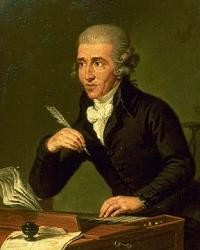Joseph Haydn
VERSION FRANCAISE DISPONIBLE. VEUILLEZ CLIQUER SUR L'ICONE (BAS DE PAGE)
His life
J. Haydn was born in 1732 in Rohrau-on-the-Leitha in Lower Austria and died in Vienna in 1809.
Then, for ten years, he continued his musical training as an independent musician, supporting himself with lessons and various jobs: In 1753 (1751?), through Metastasio, poet and author of many opera librettos of that time, he became the secretary of Nicola Porpora, a renowned singing teacher and composer, who taught him composition and introduced him to aristocratic circles.
In 1758 , he became music director for Count Carl von Morzin where he composed his first symphonies.
In 1761 , Haydn entered the service of the Hungarian princes Esterházy, of whom he would soon be the choirmaster for many years, in Eisenstadt then in Eszterhaza.
A great friendship linked Haydn and Mozart, whom he met in 1784. In 1785 , the latter persuaded Haydn to join a Masonic lodge, but this membership, unlike Mozart, would not have much influence on his work.
J. Haydn was born in 1732 in Rohrau-on-the-Leitha in Lower Austria and died in Vienna in 1809.
From the age of eight to seventeen, he was a choirboy at St. Stephen's Cathedral in Vienna.
Then, for ten years, he continued his musical training as an independent musician, supporting himself with lessons and various jobs: In 1753 (1751?), through Metastasio, poet and author of many opera librettos of that time, he became the secretary of Nicola Porpora, a renowned singing teacher and composer, who taught him composition and introduced him to aristocratic circles.
In 1758 , he became music director for Count Carl von Morzin where he composed his first symphonies.
In 1761 , Haydn entered the service of the Hungarian princes Esterházy, of whom he would soon be the choirmaster for many years, in Eisenstadt then in Eszterhaza.
A great friendship linked Haydn and Mozart, whom he met in 1784. In 1785 , the latter persuaded Haydn to join a Masonic lodge, but this membership, unlike Mozart, would not have much influence on his work.
In 1790 , only three months after the death of the first prince Nicholas, Haydn, finally freed from the obligations of his office, left for London, where he made two stays (1791-1792, 1794-1795) and received an enthusiastic welcome.
Between 1792 and 1794 , Haydn had the young Beethoven (22 years old) as a pupil.
On his return from England in 1795 , he resumed regular service with the new Prince Nicholas II Esterházy, who left Esterhaza for Eisenstadt.
Between 1792 and 1794 , Haydn had the young Beethoven (22 years old) as a pupil.
On his return from England in 1795 , he resumed regular service with the new Prince Nicholas II Esterházy, who left Esterhaza for Eisenstadt.
Haydn followed the court until 1803 , but then his health no longer allowed him to be active, he did not leave his house in Gumpendorf near Vienna until his death in 1809.
His Work
Haydn excelled above all in the symphony, the string quartet and the oratorio.
Among his most beautiful works, we will remember:
Symphonies
Symphonies No. 6 ("Le Matin"), No. 7 ("Le Midi") and No. 8 ("Le Soir") (1761).
Among the "Sturm und drang" symphonies: Symphonies No. 44, No. 45 "Les Adieux", No. 51.
6 "Parisian" Symphonies No. 82 to 87 (1785-1786) including "L'Ours" (No. 82), "La Poule" (No. 83) and "La Reine de France" (No. 85).
Symphony No. 92, in G major, "Oxford" (1789)
12 London Symphonies Nos. 93 to 104 (1791-1795), including "The Surprise" (No. 94), "The Miracle" (No. 96), "Military" (No. 100), "The Clock" (No. 101), "Timpani Roll" (No. 103) and "London" (No. 104).
Concertos
First Cello Concerto, in C major
Second Cello Concerto, in D major. (1783)
Trumpet Concerto (1796)
Chamber music
The last quartets:
- Six string quartets “Erdödy”, opus 76, (1797) including “Les Quintes” (no. 76), “L'Empereur” (no. 77) and “Lever de soleil” (no. 78).
- Two string quartets "Lobkowitz", opus 77 (1799)
The last 5 piano sonatas Hob.XVI 48 to 52 (1789 to 1794)
Oratorios
The 7 last words of Christ (orchestral version: 1787, vocal version: 1796)
The Creation (1798)
The Seasons (1801)
Operas
Acide e Galatea (1762)
Lo Speziale ("The Apothecary") (1768)
L'Infedeltà delusa (The foiled infidelity) (1773)
La Vera Costanza (1779)
Armida (1783)
Orfeo ed Euridice (1791)
His Work
Haydn excelled above all in the symphony, the string quartet and the oratorio.
Among his most beautiful works, we will remember:
Symphonies
Symphonies No. 6 ("Le Matin"), No. 7 ("Le Midi") and No. 8 ("Le Soir") (1761).
Among the "Sturm und drang" symphonies: Symphonies No. 44, No. 45 "Les Adieux", No. 51.
6 "Parisian" Symphonies No. 82 to 87 (1785-1786) including "L'Ours" (No. 82), "La Poule" (No. 83) and "La Reine de France" (No. 85).
Symphony No. 92, in G major, "Oxford" (1789)
12 London Symphonies Nos. 93 to 104 (1791-1795), including "The Surprise" (No. 94), "The Miracle" (No. 96), "Military" (No. 100), "The Clock" (No. 101), "Timpani Roll" (No. 103) and "London" (No. 104).
Concertos
First Cello Concerto, in C major
Second Cello Concerto, in D major. (1783)
Trumpet Concerto (1796)
Chamber music
The last quartets:
- Six string quartets “Erdödy”, opus 76, (1797) including “Les Quintes” (no. 76), “L'Empereur” (no. 77) and “Lever de soleil” (no. 78).
- Two string quartets "Lobkowitz", opus 77 (1799)
The last 5 piano sonatas Hob.XVI 48 to 52 (1789 to 1794)
Oratorios
The 7 last words of Christ (orchestral version: 1787, vocal version: 1796)
The Creation (1798)
The Seasons (1801)
Operas
Acide e Galatea (1762)
Lo Speziale ("The Apothecary") (1768)
L'Infedeltà delusa (The foiled infidelity) (1773)
La Vera Costanza (1779)
Armida (1783)
Orfeo ed Euridice (1791)




